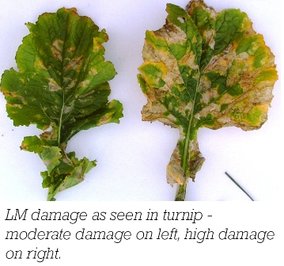Leaf miner
Scaptomyza flava
Leaf miners (LM) are flies which are found throughout NZ. The larvae live in leaf tissue, in the mines or tunnels they create as they feed. They have a wide range of host plants, including most brassicas.
Identification
Adult LM flies are small, about 2-3 mm long and are usually black with or without yellow areas on the body or the legs.
LM larvae are small, yellowish-green headless maggots with black rasping mouthparts.
Their eggs are laid on or in leaf tissue and the larvae feed on this after hatching. ‘Mines’ are created according to the feeding habit of the miner, usually by feeding within the leaf, while the two outside layers remain intact. This can result in large windows of damage in the leaf.
Mining damage can occur on young seedlings and mature plants. The fly breeds year round and under dry conditions pupae may remain dormant for up to 300 days. The fly pupates out of the host leaves and drops on to the soil or leaf litter.
Plant damage is directly related to the extent of tissue destroyed by mining, reducing photosynthetic tissue and reducing crop yield. Mining damage can also lead to early leaf senescence and fall, further reducing harvestable yield.

Prevention and management
A number of parasitoids have been developed against LM in NZ, including Asobara persimilis which has been shown to cause significant levels of parasitism in localised populations.
The removal of alternative hosts such as fathen and sowthistle prevents a buildup of population numbers, and can minimise extent of damage later. Good seed bed cultivation also minimises outbreaks.
Insecticides can be applied to minimise damage by LM, however care is needed in application, as the larvae feed on the inside of leaf tissue. An insecticide that penetrates the leaf cuticle is essential.

